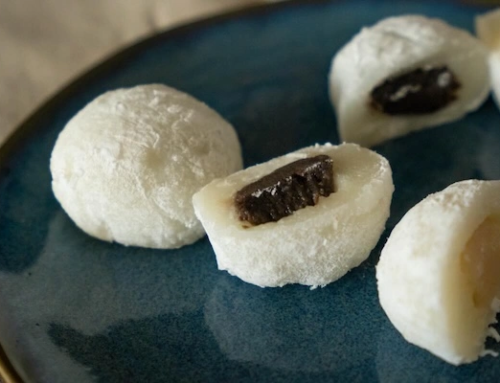Mochi Daifuku will be a widely popular dessert around the globe outside of Japan. The soft and chewy outside and delicate interior texture gratify people’s senses around the globe, from Asian markets to European and North American upscale dessert shops. With the globalizing world comes the advantage bestowed upon producers to produce on a high volume without ever compromising quality, consistency, and efficiency.
One of the good solutions for that problem is automation in the form of an encrusting machine. From single-stroke encrusting filling, encrusting machines are the new generation must-have equipment in mochi production. But aside from easy shaping, what else do these machines do? How do they work? And what do the producers need to prepare before they are able to include them in their lines?
Here in this guide, we’ll be covering the use, production, environment, and integration considerations of Mochi Daifuku encrusting machines. Whether you’re making 1,000 or 100,000 a day, selecting the right thing will enable you to select equipment that’s proportionally sized to you and avoid inefficient bottlenecks.
1. What Is the Mochi Daifuku Encrusting Machine?
On its own, the mochi daifuku encrusting machine automates the process of encasing a center filling with soft mochi dough. This does not appear to be a sophisticated or high-technology task, but industrial volumes in the order of tens of thousands of units per hour, as is common in food factories today, require an exponentially more sophisticated and intricate engineered solution to deliver quality, hygiene, and high yields consistently.
1) Encrusting Workflow
The factory-stage encrusting process features a fully controlled multi-step process workflow:
- Loading Raw Material: Outer mochi dough and inner filling are separately loaded into two large hoppers. Dough is kept at optimal temperature and humidity levels to ensure softness and elasticity for extended production runs. The filling hopper may be equipped with stirrers or temperature control, especially if it’s working with sticky, creamy, or temperature-sensitive foods such as chocolate or ice cream.
- Coaxial Extrusion: Through a concentric nozzle system, the machine simultaneously extrudes filling and dough. In proportion to the outer shell and set to a specific degree, servo motors and flow sensors control the filling. Shell-to-filling on-the-fly shut-off ratio adjustment is achieved without shutting down the machine.
- Pre-Forming and Shaping: There is a pre-forming chamber or mold after the nozzle, which shapes the product into a form—a regular, smooth, round Daifuku ball. There is gentle mechanical handling that prevents mochi surface breakage but leaves the surface clean and smooth in appearance.
- Precision Cutting: Accurately designed cutters—mechanical, pneumatic, or ultrasonic—cut the product strand into uniform units of programmed weight or time increments. Weight sensors may give feedback to the machine in real-time for automatic adjustment of minor deviations.
- Conveying and Synchronization: Finished units are transported on a conveyor to subsequent operations of dusting with flour, freezing, or packaging. Conveyor speed and synchronization are coordinated with the cutter and extruder to avoid bottlenecks and ensure continuous flow.
2) Core Industrial Benefits
- High-Speed Output: Designed to run 5,000 to 30,000 pieces per hour, depending on product size and machine configuration.
- Multi-Shift Operation: Heavy-duty food-grade stainless steel components and wear-resistant materials are used for 24/7 operation with low maintenance.
- Contamination Control: Sealed loops, self-closing hoppers, and sanitary design aspects (e.g., CIP sanitizing compatibility) reduce the possibility of bacterial contamination, meeting HACCP and GMP requirements.
- Digital Parameter Control: Product weight, diameter, filling ratio, and extrusion pressure are adjusted by operators through a master touch panel so that product SKUs are altered at high speed without mechanical reconfiguration time.
Example: Real-World Application in Factory Production
In a typical-sized factory, the encrusting machine is combined with a spiral freezer and flour dusting. It has a production rate of 20,000 filled mochis per hour with less than 1.5% product variation. Changeovers between matcha cream and red bean paste take less than 10 minutes because onboard digital recipe presets and quick-release parts enable sanitation.

2. Major Ingredients of Mochi Daifuku Encrusting Machine
Regardless of whether encrusting machines are a bit differently shaped from one model or manufacturer to another, the inner composition is built on the same principle. That is the function of the key components:
- The Dough Hopper: Contains and conditions the mochi dough. In certain machines, it might have temperature controls, so it warms the dough for extended operations.
- The Filling Hopper: Provides and keeps the filling in the center. High-end models have a rotary mixer or cold cell for uninterrupted flow of adhesive or spread fillings.
- The Extrusion System: Likely the machine’s heart. Provides dough and filling in equal proportions. Servo motors, pressure sensors, and flow governors all work together to keep it in balance.
- The Shaping Mechanism: Compression chambers, molds, or rollers, depending on end product shape—round, capsule, or special—break-less and distortion-less shaping is achieved by equipment.
- The Cutter: Mechanical, pneumatic, or thermal cutting devices are used in this step to divide the continuous mochi strand into discrete units by time or weight.
- The Conveyor: Delivers finished units to the next step in the process, either freezing, tray loading, or packaging.
Table: Typical Flow Sequence
| Stage | Description |
| Dough & filling loading | Raw ingredients are loaded into hoppers |
| Coaxial extrusion | Outer dough and inner filling combined |
| Forming | Product formed into the desired shape |
| Cutting | Units are cut into uniform pieces |
| Conveying | Moved downstream for further operations |
These parameters need to be matched. Pressure or flow rate mismatch can cause types of faults like off-center filling, shell cracking, or weight variation.
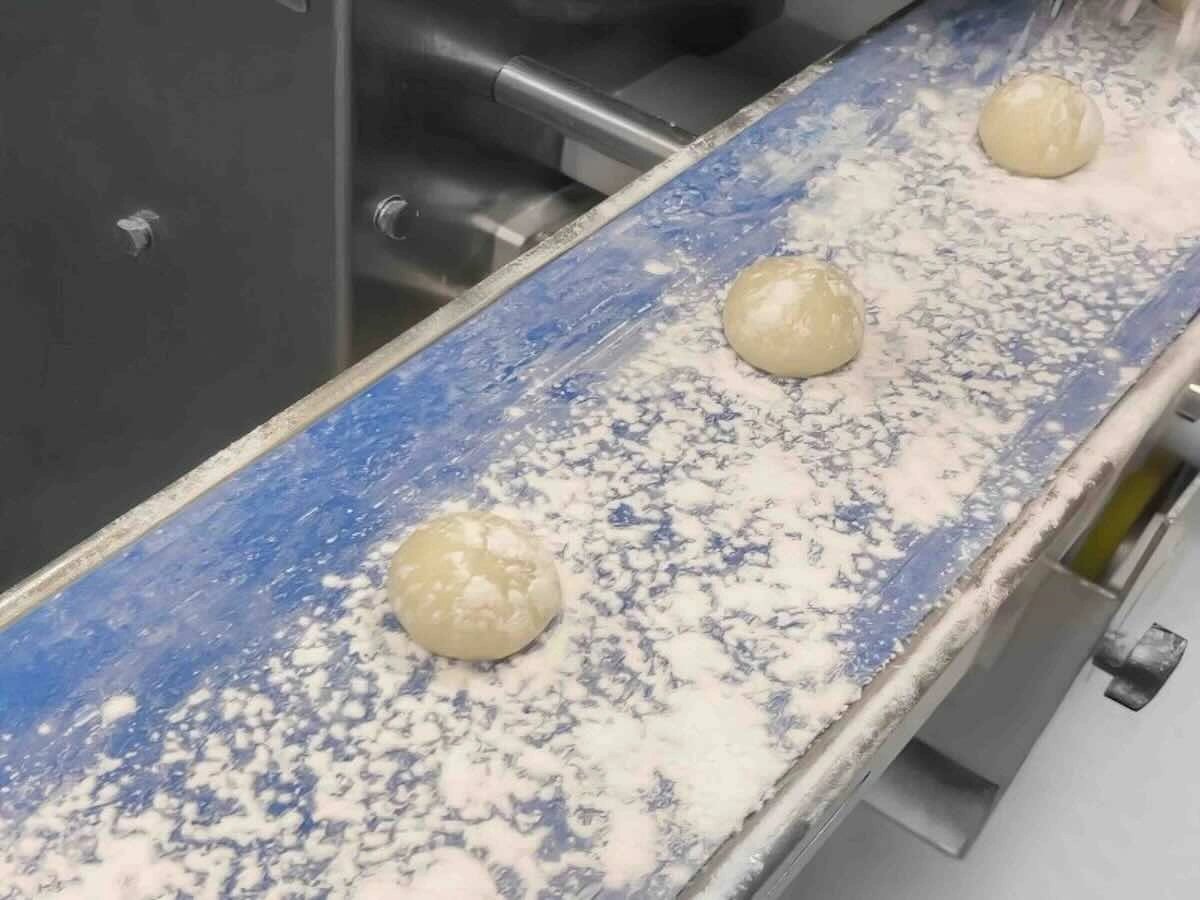
3. Intelligent Automation and Personalization Capabilities
Encrusting machines nowadays are not just mechanical machines—they are intelligent, smart machines that can be programmed to offer support for digital manufacturing environments and diversified market demands.
1) Intelligent features that drive performance
- Real-Time Monitoring and Analysis: Encrusting machines are now being equipped with onboard sensors and IoT connectivity by the manufacturer. The manufacturer can monitor production output, like unit number, error rate, and temperature, through dashboard monitoring. Data logs allow for quality control enhancement as well as traceability of manufacturing defects faster.
- Self-Cleaning Modes: To reduce downtime between product changes, some models come with automatic cleaning nozzles, hopper rinsing systems, or CIP (Clean-In-Place) facilities.
- Multi-Language Support: Systems with multi-language user interfaces (English, Japanese, Chinese, etc.) enable their deployment in overseas factory operations.
- Energy Efficiency Programs: Equipment can be set to a standby or low-power state when idle, reducing the cost of operation in mass production.
2) Deep Customization Possibilities
Manufacturers can now approach machine vendors and get systems constructed to order for specific product lines:
- Shape Modules: Molds to be swapped out quickly in order to produce heart, star, or even branded shapes for seasonal or branded products.
- Filling Variants: Two-piece (peanut butter + jelly) center injection machines for liquid fill, such as jam or lava chocolate.
- Texture Control: Through surface patterning of the mold and pressure control, the finished texture can be rustic, glossy, or matte, providing brand differentiation.
- Speed & Volume Adaptation: The equipment is adaptable to any scale of production—small R&D lots to continuous factory lines up to 30,000 pcs/hour.
These not only guarantee uniformity and purity in the product but also allow brands to be fast and innovative in coming out with new lines or limited editions with very minimal adjustments.
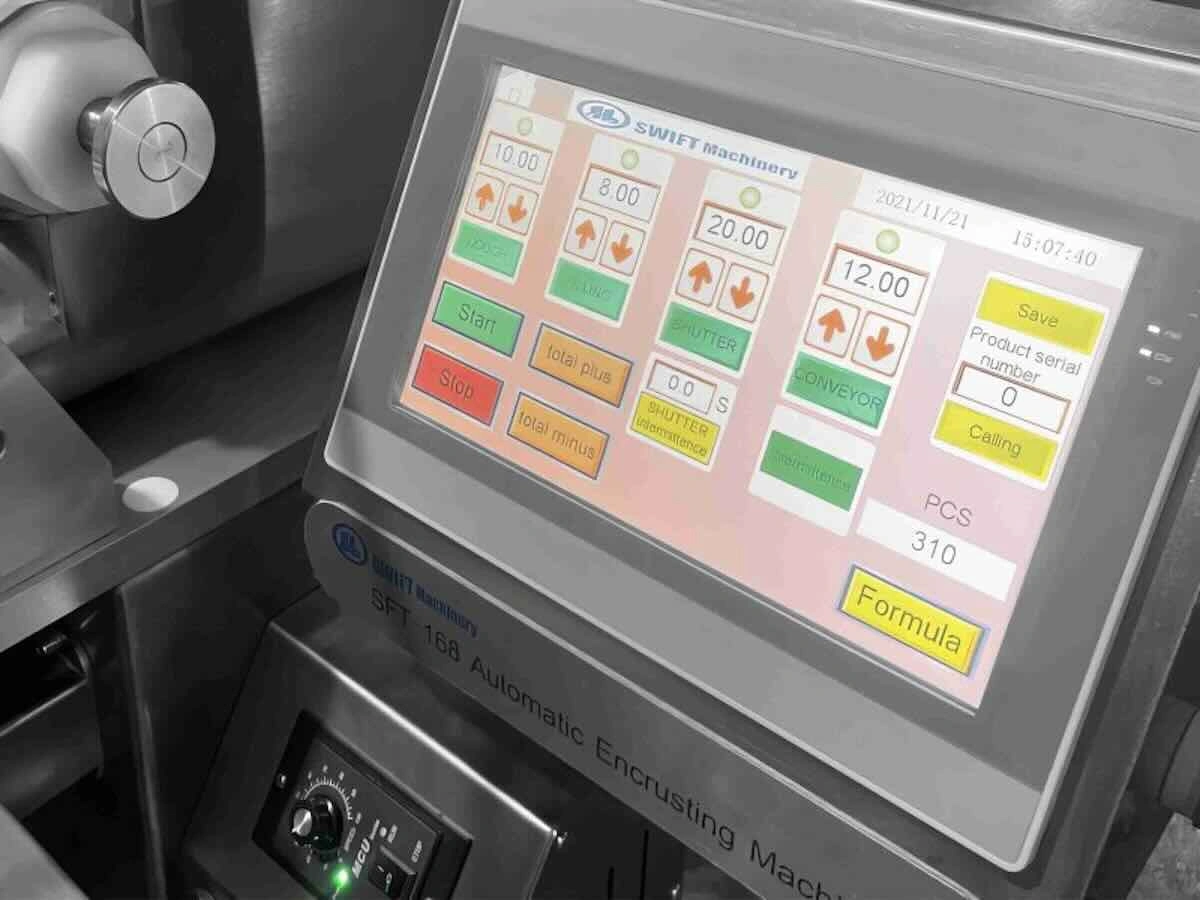
4. Mochi Daifuku Production Line
Such an encrusting machine works very well as it is, but even better on an automatic line. This is particularly required in export-grade or frozen mochi production, where yield and consistency are of the highest priority.
What an Integrated Line Is:
- Flour Dusting Unit: Anti-sticking by lightly dusting the mochi before or after shaping.
- Cooling or Freezing Tunnel: Required for temperature-sensitive filled foods or ice cream mochi.
- Tray Loading System: Packages or trays are loaded with the product by pneumatic or robotic loading without deforming the shape.
- Packaging Machine: Flow wrappers, vacuum packers, or MAP systems give shelf life and freshness.
- Coding & Labeling: Codes retail batch number, use-by-date, or QR traceability code.
Integration is modular. Downstream and encrusting machines are available on a plug-and-play basis from most suppliers in the majority of applications, and the time and cost to integrate the line are minimal.
For instance, in a Japanese factory producing over 20,000 mochi per hour, the encrusting machine has been integrated with a robot tray loader and spiral freezer, and 70% of labor and under 2% of waste are saved.
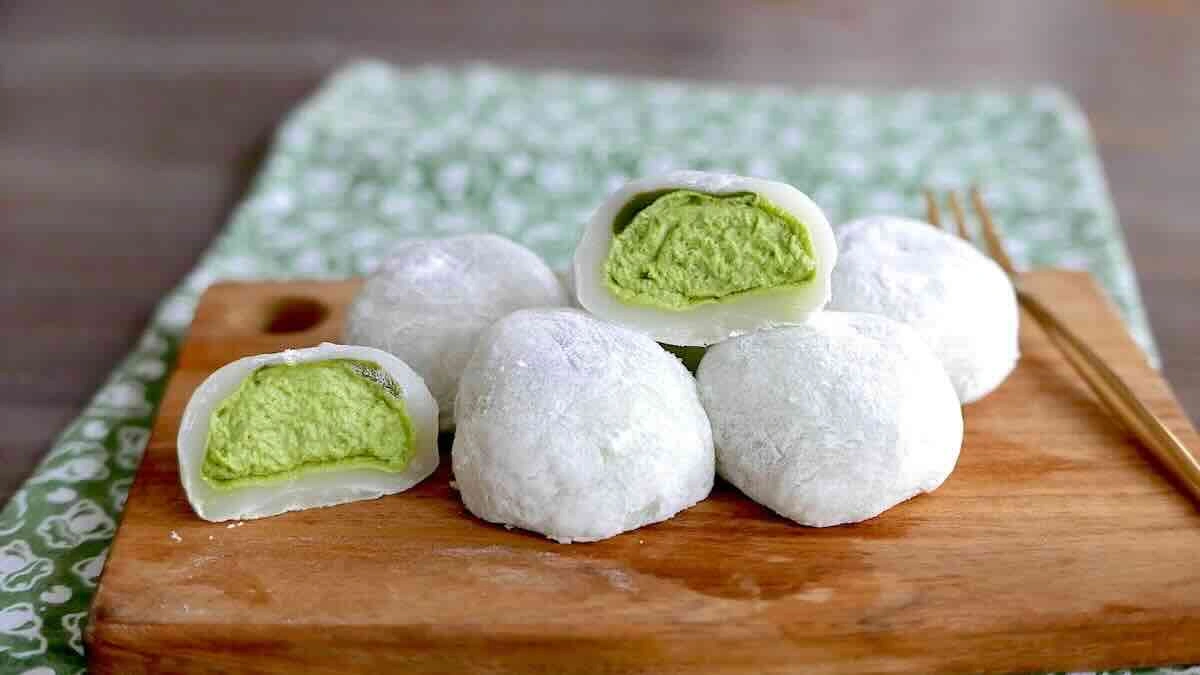
5. Applications of Mochi Daifuku Encrusting Machine
Mochi Daifuku encrusting machines are extremely versatile and are utilized far beyond Japanese traditional desserts today. Their adaptability to different types of dough and filling has created opportunities for other product applications in global markets.
1) Expanding Beyond Traditional Mochi
The machines are utilized to make:
- Fruit-Filled Mochi: With tropical flavors such as mango, passionfruit, or lychee for Southeast Asian, U.S., and European dessert markets.
- Savory Mochi Bites: Containing cheese, curry, ground meat, or spicy tuna—ideal for ready-to-eat snack pack formats or bento partners.
- Ice Cream Mochi: Using cryogenic extruders and chilled hoppers, the machines encapsulate hot, tacky dough into cold dairy or non-dairy fillings to create freezer shelf food.
- Mini Mochi Balls: Designed for single-serve or convenience packaging in vending machines, airline snack trays, or lunch packs.
- Functional Health Snacks: Collagen, matcha, protein powder, or dietary fiber-fortified mochi are some possibilities for the health-conscious consumer to target.
2) Suitable for Diverse Business Models
Low-volume gourmet stores or high-volume OEM manufacturers, encrusting machines support different formats and markets:
- Artisan Brands: Produce custom-designed or two-color mochi with high-quality ingredients for premium gift packs or gourmet cafes.
- Food Service and Catering: Employ larger sizes (60–100g) for restaurant and hotel dessert plates.
- Retail Chains: Provide private label ambient or frozen products in store brands in bulk.
- Export-Ready Factories: Meet international compliance and packaging standards for export distribution.

6. Future-Proofing Your Mochi Production
It is not about today’s manufacturing when investing in the proper encrusting machine; it is about future-proofing the food business.
1) Built for Growth and Flexibility
- Modular Expansion: Installation of add-on accessories like embossing modules, shaping presses, or texture decorators on machines is possible as your product line expands.
- Multi-SKU Readiness: Electronic memory and recipe storage enable quick switch between one product line or seasonal flavor without a radical reconfiguration.
- Scalable Design: Begin with semi-automatic operation and introduce automated tray loaders, packaging machines, or freezing tunnels for complete utilization in production lines.
2) Aligned with Emerging Trends
- Sustainability Support: Compostable film, biodegradable trays, and energy-efficient operation can be used on new equipment to meet environmental compliance.
- Remote Monitoring and Predictive Maintenance: Real-time performance from cloud-based systems warns operators in advance of breakdown, minimizing downtime.
- Food Safety & Compliance: Equipment is being designed to comply with FDA, CE, and UL specifications, with the possibility of easy cleaning and allergen control compatibility.
- Smart Integration: Encrusting lines can now be fully integrated into Industry 4.0 production lines, providing data to MES/ERP systems for better planning and traceability.
Future-proof encrusting machines provide manufacturers not only with performance today but also insurance for tomorrow, whatever tomorrow may bring – getting new lines of product to market, complying with new safety regulations, or reducing their carbon footprint.
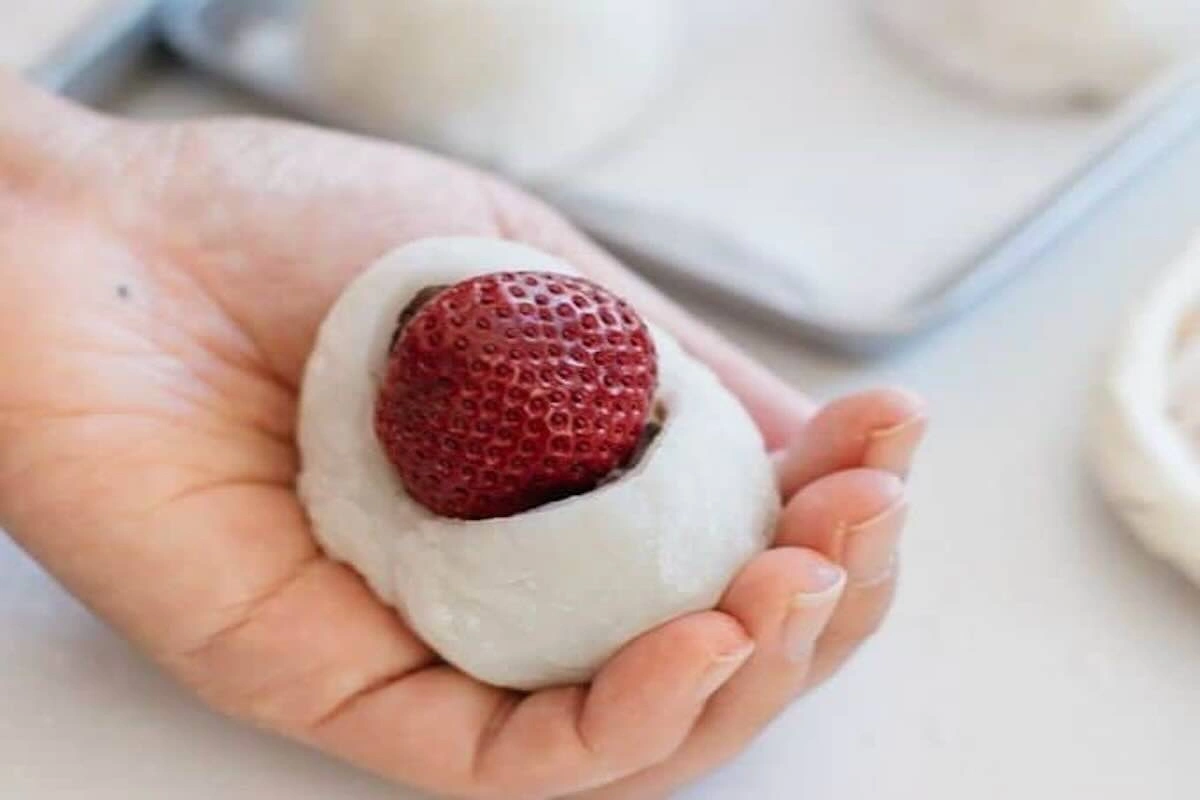
6. Conclusion
Encrusting machines are the answer to Mochi Daifuku production today. Not only do they save time, but they also offer unbeatable consistency, versatility, and productivity. Investing in one will be a suggestion any producer who wishes to remain in tune with growing demand without sacrificing quality will be well-advised to follow.
You need to know something about how the machine operates, what it will do, and where it will fit into some greater production flow. If you are a small factory doing your first run or a large factory that is looking to export, the right encrusting machine will not only perform wonders for your company—it will also open up whole new opportunities.

